if the collection of uncondensed hydrocarbon or gas is possible can you tell me what is the possible uses of those collected gas? and can you suggest a special feature for wax trapping to prevent clogging in the whole system specially in condenser.thanks.
Announcement
Collapse
No announcement yet.
How to turn plastic waste into diesel fuel cheaply
Collapse
X
-
Here are some better photos of the ice quench portion of my WMO distillation unit:
Ice quench
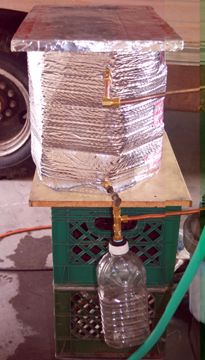
The two samples side by side. The 75F (25c) quench sample is on the right. The 32F (0c) is on the left

Ice bath first loaded
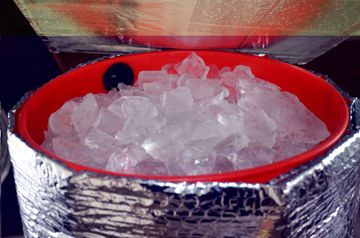
Ice bath after 24 hours
 I have been running various blends of waste oils and unleaded gasoline in a 1983 Chevy G-20 van with a 6.2L diesel V-8 engine, with a Stanadyne Rotary DB2 IP since Feb, 2007. I have started the engine with no difficulty and no block heater on an 80/20 (WVO/gas) blend down to 0F (-18c). I have found that by blending as little as 15% gasoline in the summer, and as much as 50% in the winter, my engine starts and runs as if it was running on diesel fuel.
I have been running various blends of waste oils and unleaded gasoline in a 1983 Chevy G-20 van with a 6.2L diesel V-8 engine, with a Stanadyne Rotary DB2 IP since Feb, 2007. I have started the engine with no difficulty and no block heater on an 80/20 (WVO/gas) blend down to 0F (-18c). I have found that by blending as little as 15% gasoline in the summer, and as much as 50% in the winter, my engine starts and runs as if it was running on diesel fuel.
Comment
-
Now that I have separated my "crude" into petrol/gasoline I want to test the quality of the two fuels.
The separation was done on a simple improvised still. The heat source was a small 1200watt electric ring. The boiler was a 20litre tin oil drum. the reflux column and condenser was made from copper pipe. Here is a picture of the still, I hope you can make out the details, my workshop is sort of crammed with stuff. what you see behind the still is my forge.

Comment
-
At present I dont have a kerosene fueled heating system in my home. ( I heat my home with the by product of my biodiesel process.) But I do have a small kerosene stove made by a Danish company called Refleks and I dusted it off and connected it up to test my kerosene. These excellent little stoves are used in fishing boats, yachts, caravans etc. It lit easily and got up to heat quickly and I ran it for 6 hours on one litre of my kerosene. After it cooled down I opened it up and had a look, no soot, no residue, happy days.

Comment
-
Final and the ultimate test for my kerosene. I filled up a hurricane lamp and lit it. It burned nicely with a bright flame. I carried it from my workshop to my house and placed it a shelf in our living room. Immediately my wife asked why I was bringing one of those smelly lamps into the house. I told her I was trying out a new fuel and she should tell me as soon as she smelt any fumes. Its been four hours now and she has not complained.


Comment
-
what temp do run your reactor at when distilling wmo?Originally posted by Beyond Biodiesel View PostHere are some better photos of the ice quench portion of my WMO distillation unit:
Ice quench

The two samples side by side. The 75F (25c) quench sample is on the right. The 32F (0c) is on the left

Ice bath first loaded

Ice bath after 24 hours

Comment
-
Pressure inside reactor
Dear Beyond Biodiesel ,Originally posted by Beyond Biodiesel View PostYou definitely do not want to have a blockage in your reactor, or Oops, caboom!!!
However, cat cracking units at petroleum refineries are typically run at higher than ambient pressures. The cat cracking units I operated for Chevron Research were typically operated at 15 PSI above ambient.
Running a cat cracking units at 15 PSI above ambient means you can expose the heavy fractions to higher temperatures before they leave the cat cracking unit, which promotes cracking.
Thermal cracking of hydro carbons begins at the boiling point of the hydrocarbon and increases significantly at 600F (300C). So, increasing the temperature at which the heavy fractions are exposed increases cracking, even without the presence of a catalyst.
The device needed for increasing the pressure inside the cat cracking unit is a reverse pressure regulator. We at Chevron used something called a "research valve" which was this reverse pressure regulator that could handle temperatures of about 800F (425c).
Yesterday I did an experiment with vacuum distillation of waste 2-stroke gasoline that had been contaminated with WMO. I poured 10 gallons of waste 2 stroke gasoline, which is known to be contaminated with WMO, into my 20 gallon processing tank, then I ran 30 feet of 1" ID vacuum hose to my vacuum distillation unit, to see if I could easily extract the gasoline component from the WMO, so that I could use it for blending.
In 2 minutes of pumping I got the tank down to 23"HG, within another minute I noticed precipitate collecting in my water quenched sample container. The drip rate at first was 1/second. After 2 hours the drip rate dropped to 1/20seconds. This is all I got after 2 hours of vacuum only distillation at about 82F ambient temperature.
You will notice an emulsion layer. I am guessing that the bottom layer is water. The top layer is most probably gasoline.
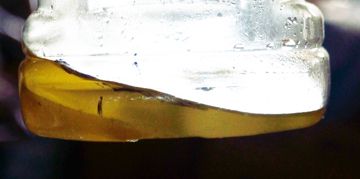
I also ran an ice quench to see if I got anything from it. I did, so anyone distilling WMO, or cracking plastics is going to want an ice quench.
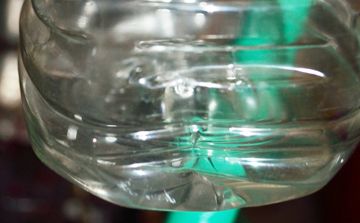
Here is the equipment
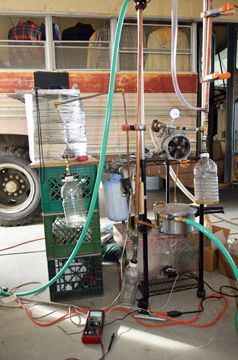
Thanks for the input . Indeed what you said the pressure inside the reactor will increase residence time of vapors inside reactor and thus heavy fraction will crack in to lighter fractions . The problem with this arises when some wants to commercialize the process , and when the pressure increases the gas out put increases ...I hope what I am saying is order if not correct me .
Measure concern with commercialization of the pyrolysis process is that the process should yield more liquid fraction ... and it should be continuous process and not batch one . Artillery blockage problem is ruled out in continuous process . This problem occurs with batch processes .As one cools and heats the reactor . When one cools the reactor , pipeline also gets cooled and thus promoting artillery blockage problem .
Suneel
Comment
-
Another important reason to maintain some positive pressure in the reactor is safety. If a leak occurs it is much better ( although not good) to have vapours escaping than air getting in.
Continuous processing will not solve the problem of artillery blockages, and in fact could make them worse. Delivery of fresh feedstock can mean sudden increases of steam, syngas, and hydrocarbon vapours. Your pipework must be designed to handle these without blockages.
Comment
-
The above experiment was conducted with a vacuum pump on an unheated tank of 10 gallons (40L) of waste 2-stroke fuel.Originally posted by thissideup View Postwhat temp do run your reactor at when distilling wmo?
I am working on a continuous process. If you want to go commercial, then there are plenty of systems already in place that one can just buy "off-the-shelf." I recommend you not try to reinvent the wheel, if you are going commercial. Just buy a pyrolysis or WMO recycling system from a reputable engineering firm, and save yourself a lot of trouble.Originally posted by ndsunil View PostDear Beyond Biodiesel ,
Thanks for the input . Indeed what you said the pressure inside the reactor will increase residence time of vapors inside reactor and thus heavy fraction will crack in to lighter fractions . The problem with this arises when some wants to commercialize the process , and when the pressure increases the gas out put increases ...I hope what I am saying is order if not correct me .
Measure concern with commercialization of the pyrolysis process is that the process should yield more liquid fraction ... and it should be continuous process and not batch one . Artillery blockage problem is ruled out in continuous process . This problem occurs with batch processes .As one cools and heats the reactor . When one cools the reactor , pipeline also gets cooled and thus promoting artillery blockage problem .
Suneel
I agree with imakebiodiesel.Originally posted by imakebiodiesel View PostAnother important reason to maintain some positive pressure in the reactor is safety. If a leak occurs it is much better ( although not good) to have vapours escaping than air getting in.
Continuous processing will not solve the problem of artillery blockages, and in fact could make them worse. Delivery of fresh feedstock can mean sudden increases of steam, syngas, and hydrocarbon vapours. Your pipework must be designed to handle these without blockages.I have been running various blends of waste oils and unleaded gasoline in a 1983 Chevy G-20 van with a 6.2L diesel V-8 engine, with a Stanadyne Rotary DB2 IP since Feb, 2007. I have started the engine with no difficulty and no block heater on an 80/20 (WVO/gas) blend down to 0F (-18c). I have found that by blending as little as 15% gasoline in the summer, and as much as 50% in the winter, my engine starts and runs as if it was running on diesel fuel.
Comment
-
Commercial pyrolysis?
Aside from the (overpriced) Blest mini-unit what equipment is available for the individual?
Comment
-
Commercial project
Dear All ,Originally posted by Beyond Biodiesel View PostThe above experiment was conducted with a vacuum pump on an unheated tank of 10 gallons (40L) of waste 2-stroke fuel.
I am working on a continuous process. If you want to go commercial, then there are plenty of systems already in place that one can just buy "off-the-shelf." I recommend you not try to reinvent the wheel, if you are going commercial. Just buy a pyrolysis or WMO recycling system from a reputable engineering firm, and save yourself a lot of trouble.
I agree with imakebiodiesel.
Indeed commercial projects from repute companies cost a lot .. Indeed they ask USD 5000/- up front and so .. for giving a quote only . Off course if you place an order they consider this an advance .. but if you do not place it is non refundable one ...
One needs to design a commercial plant which will have a reasonable cost and will mankind from pollution point of view .. Indeed I want do it .. And once it is through I shall share here on this platform positively. Indeed a lot spade work has been done at my end ..Let us hope ...
Comment
Comment